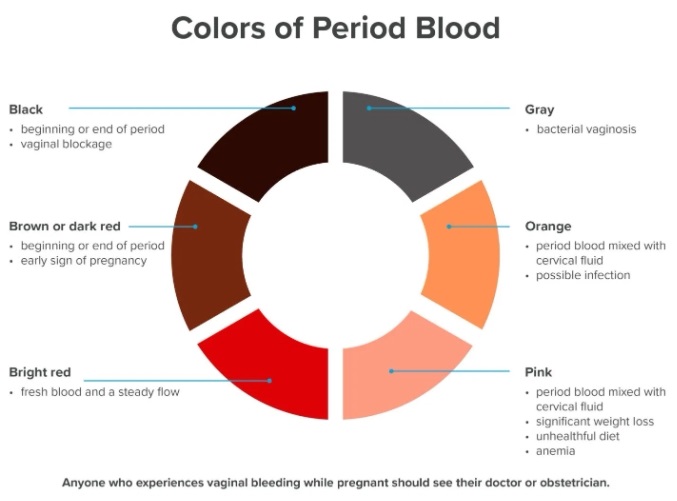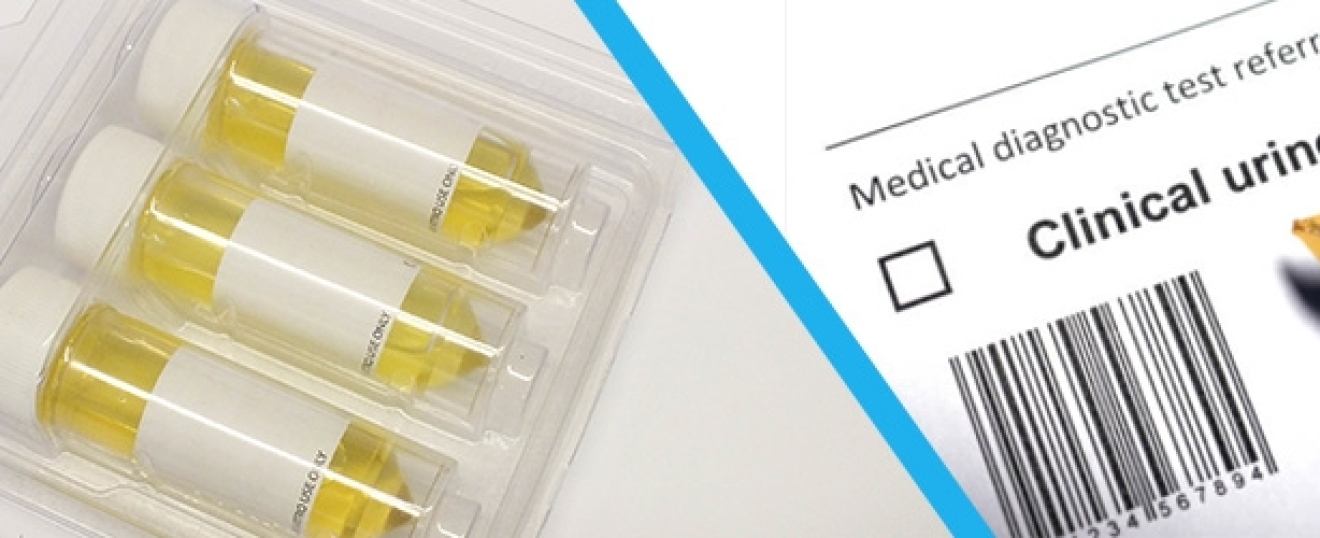- 07736 104738
- sam@medicalmassagelady.com
- Mon - Sat, 8:00 - 18:30
Articles
The colour of menstrual blood can provide important health information such as a vaginal infection.
During menstruation, the body sheds tissue and blood from the uterus through the vagina and this discharge may range in colour from bright red to dark brown or black depending on how old it is.
Blood that stays in the uterus long enough will react with oxygen (oxidize). Blood that has had time to oxidize appears darker, hence why endometriotic lesions appear blue or black on laparoscopy films.
Hormonal changes and health conditions will also affect the colour and texture.

COLOUR OF MENSTRUAL BLOOD
BLACK/BROWN/VERY DARK RED
- May appear at the beginning or end of a period
- generally a sign of old blood which has had time to oxidize, first turning brown or dark red and then eventually becoming black
- may also indicate a blockage inside the vagina, particularly if any of the following symptoms are also present:-
- foul-smelling discharge
- fever
- difficulty urinating
- itching or swelling in or around the vagina
DURING PREGNANCY
Brown blood or spotting may be an early sign of implantation bleeding in pregnancy
Brown discharge/spotting during pregnancy may indicate miscarriage or an ectopic pregnancy
It is important for women who experience spotting or vaginal bleeding during pregnancy to speak to their doctor or obstetrician.
LOCHIA/POSTPARTUM BLEEDING
Lochia is the body’s way of expelling excess blood and tissue from the uterus, usually starting with bright red blood and then becoming a darker shade as the flow decreases.
The duration of lochia varies, but usually passes within the first few months after delivery, but if there is very heavy bleeding after giving birth you should see a doctor.
BRIGHT RED
A period may begin with bright red fresh bleeding and darken towards the end of the period. Some people may find that their blood stays bright red throughout their period.
Spotting or bleeding between menstrual cycles may indicate:-
- a sexually transmitted infection, eg. chlamydia or gonorrhoea
- growths in the uterine lining eg. polyps or fibroids
- cervical cancer
Other symptoms of cervical cancer include:-
- heavier periods
- periods that last longer than normal
- bleeding after sexual intercourse
- foul-smelling vaginal discharge
- pain in the lower back, pelvis, or legs
- loss of appetite
- unexplained weight loss
PINK
Pink blood or spotting happens as a result of period blood mixing with cervical fluid. This may happen due to:-
using hormonal contraceptives can lower oestrogen levels
sexual intercourse may cause small vaginal/cervical tears and blood from these tears mixes with vaginal fluids thus creating pink discharge
significant weight loss
unhealthy diet
anaemia
DURING PREGNANCY
If there is pink discharge containing tissue alongside cramps this may indicate a miscarriage.
ORANGE
Blood that mixes with cervical fluid can also appear orange, but if accompanied by vaginal itching, discomfort, and foul-smelling discharge, this is likely a sign of infection such as bacterial vaginosis or trichomoniasis.
GREY
- Grey discharge usually indicates bacterial vaginosis infection, which occurs due to an imbalance between harmful bacteria and the natural flora in the vagina.
- Other symptoms of bacterial vaginosis include:-
- itching in and around the vagina
- foul-smelling vaginal odour that people often describe as “fishy”
- burning or painful urination
This usually requires antibiotic treatment.
DURING PREGNANCY
During the later stages of pregnancy, grey discharge containing clots may indicate a miscarriage.
Hormonal changes, diet, lifestyle, age, and environment, can all cause variations in period blood.Any unusual blood colour or irregular bleeding should be referred to a GP/gynaecologist.
TEXTURE OF MENSTRUAL BLOOD

Healthy period blood may contain visible pieces of the uterine lining and this is normal, but very heavy bleeding or large clots may indicate menorrhagia, or unusually heavy periods lasting longer than 7 days, which can lead to anaemia and chronic fatigue.
It is recommended that you see a doctor if any of the following apply:-
- bleeding that requires a person to change a tampon or pad after less than 2 hours
- blood with clots that are the size of a penny or bigger
Causes of menorrhagia:-
- growths on the uterus, such as uterine fibroids or polypshormonal imbalances
- pelvic inflammatory disease
- intrauterine birth control devices (IUD)
- bleeding disorders, such as von Willebrand disease
- certain medications, such as aspirin and anticoagulants
- cervical or uterine cancer
If any of the following apply you should see a doctor/gynaecologist:-
- new or unusual vaginal discharge
- irregular periods that change in length and flow from one month to the next
- bleeding after menopause
- missing three or more periods
- foul-smelling vaginal odour
- thick grey or white vaginal discharge
- itching in or around the vagina
- fever
Large frequent blood clots in a heavy and long period may indicate any of the following:-
- uterine fibroids- muscular growths that line the uterine wall
- adenomyosis – accumulation of tissue in the uterus
- polycystic ovarian syndrome (PCOS) - cysts and swelling in your ovaries
- endometriosis – growth of endometrial tissue outside of the uterus
- polyps - small, benign growths in the endometrial lining
- endometrial cancer - malignant tumours in the reproductive organs
- bleeding disorders
- thyroid conditions
- complications from an intrauterine device (IUD)
- vitamin K deficiency
Anyone who is pregnant and notices any bleeding or unusual vaginal discharge should speak with their doctor/obstetrician.
STRINGY
Blood that is stringy, sticky, or clumpy is completely within the normal scope of period blood.Stringy blood is simply a blood clot leaving the uterus, often in the first one or two days of your period where bleeding is heavier.Stringy blood usually has a sticky consistency with a high endometrial tissue content and is usually dark or bright red.
CLUMPY
In the later part of a period, there may be jelly-like or clumpy blood, which is usually caused by blood clots passing through the body. This is normal and may be bright red, dark red, or brown.
WATERY
Towards the end of the period, blood may be more watery and may darken due to oxidisation.Bright red and watery blood is fresh straight from the uterus, possibly suggesting an injury or miscarriage.
You should also see a doctor if any of the following apply:-
- bruising easily, fatigue, or shortness of breath, all of which can indicate anaemia
- increased cramping during your period
- pain or bleeding during or after sex
- clots that appear to grow larger in size as your period progresses
- soaking through pads every hour or soaking through your outer clothing
- watery discharge that’s bright red or grey
- heavy period bleeding that increases or continues after 7 days (menometrorrhagia)
The colour and consistency of period blood can provide useful information but you should also recognise what is normal for you.
Healthy period blood typically varies from bright red to dark brown or black. Blood or discharge that is orange or grey may indicate an infection. Women who experience bleeding during pregnancy should see a doctor or obstetrician for an evaluation.



_large.jpg)
